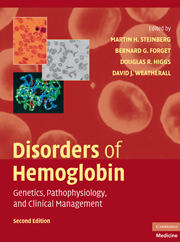Book contents
- Frontmatter
- Contents
- List of Contributors
- Foreword, by H. Franklin Bunn
- Preface
- Introduction, by David J. Weatherall
- SECTION ONE THE MOLECULAR, CELLULAR, AND GENETIC BASIS OF HEMOGLOBIN DISORDERS
- SECTION TWO PATHOPHYSIOLOGY OF HEMOGLOBIN AND ITS DISORDERS
- 8 Rheology and Vascular Pathobiology in Sickle Cell Disease and Thalassemia
- 9 The Erythrocyte Membrane
- 10 The Biology of Vascular Nitric Oxide
- 11 Mechanisms and Clinical Complications of Hemolysis in Sickle Cell Disease and Thalassemia
- 12 Animal Models of Hemoglobinopathies and Thalassemia
- SECTION THREE α THALASSEMIA
- SECTION FOUR THE β THALASSEMIAS
- SECTION FIVE SICKLE CELL DISEASE
- SECTION SIX OTHER CLINICALLY IMPORTANT DISORDERS OF HEMOGLOBIN
- SECTION SEVEN SPECIAL TOPICS IN HEMOGLOBINOPATHIES
- SECTION EIGHT NEW APPROACHES TO THE TREATMENT OF HEMOGLOBINOPATHIES AND THALASSEMIA
- Index
- Plate section
- References
11 - Mechanisms and Clinical Complications of Hemolysis in Sickle Cell Disease and Thalassemia
from SECTION TWO - PATHOPHYSIOLOGY OF HEMOGLOBIN AND ITS DISORDERS
Published online by Cambridge University Press: 03 May 2010
- Frontmatter
- Contents
- List of Contributors
- Foreword, by H. Franklin Bunn
- Preface
- Introduction, by David J. Weatherall
- SECTION ONE THE MOLECULAR, CELLULAR, AND GENETIC BASIS OF HEMOGLOBIN DISORDERS
- SECTION TWO PATHOPHYSIOLOGY OF HEMOGLOBIN AND ITS DISORDERS
- 8 Rheology and Vascular Pathobiology in Sickle Cell Disease and Thalassemia
- 9 The Erythrocyte Membrane
- 10 The Biology of Vascular Nitric Oxide
- 11 Mechanisms and Clinical Complications of Hemolysis in Sickle Cell Disease and Thalassemia
- 12 Animal Models of Hemoglobinopathies and Thalassemia
- SECTION THREE α THALASSEMIA
- SECTION FOUR THE β THALASSEMIAS
- SECTION FIVE SICKLE CELL DISEASE
- SECTION SIX OTHER CLINICALLY IMPORTANT DISORDERS OF HEMOGLOBIN
- SECTION SEVEN SPECIAL TOPICS IN HEMOGLOBINOPATHIES
- SECTION EIGHT NEW APPROACHES TO THE TREATMENT OF HEMOGLOBINOPATHIES AND THALASSEMIA
- Index
- Plate section
- References
Summary
OVERVIEW OF HEMOLYSIS IN SICKLE CELL DISEASE AND THAL ASSEMIA
Anemia is the most basic clinical characteristic of sickle cell disease and thalassemia. In sickle cell disease, the polymerization of sickle hemoglobin (HbS) causes profound changes in the integrity and viability of the erythrocyte, leading to both extravascular and intravascular hemolysis. The lifespan of the erythrocyte in sickle cell disease is often shortened to less than one-tenth of normal. In β-thalassemia intermedia and major, but not in sickle cell disease, a substantial portion of the hemolysis occurs in the intramedullary space before the developing erythrocytes can even exit the bone marrow, referred to as ineffective erythropoiesis. In either case, erythropoiesis is markedly increased, but insufficient to compensate completely for the accelerated hemolysis, resulting in chronic anemia. This chapter examines the mechanisms that give rise to the accelerated hemolysis characteristic of these hemoglobinopathies and considers emerging data suggesting that chronic intravascular hemolysis produces endothelial dysfunction and a progressive vasculopathy. The latter mechanism of disease contributes to a clinical subphenotype of complications shared by many of the hemolytic anemias, including pulmonary arterial hypertension, cutaneous leg ulceration, priapism, and perhaps stroke. The mechanisms and consequences of hemolysis differ by two main anatomical compartments: extravascular hemolysis, which primarily involves phagocytosis by macrophages in the reticuloendothelial system, and intravascular hemolysis, which occurs within the blood vessel lumen.
Approximately two-thirds of hemolysis in sickle cell disease is extravascular and one-third intravascular.
- Type
- Chapter
- Information
- Disorders of HemoglobinGenetics, Pathophysiology, and Clinical Management, pp. 201 - 224Publisher: Cambridge University PressPrint publication year: 2009
References
- 5
- Cited by



